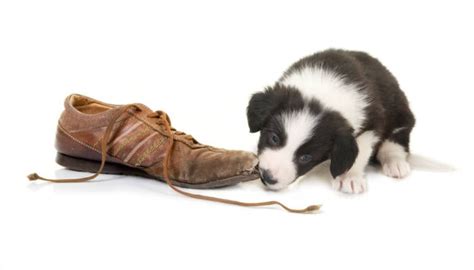Understanding the root causes of destructive chewing
Introduction: Chewing is a natural behavior for dogs, but when it becomes destructive, it can be frustrating for dog owners. In order to tackle this issue effectively, it is important to understand the root causes behind destructive chewing. By identifying and addressing these causes, dog owners can help redirect their dog’s chewing behavior towards appropriate alternatives.
1. Boredom and Insufficient Exercise: Dogs are active animals that require mental and physical stimulation. When dogs are left alone for long periods without enough exercise or playtime, they often resort to destructive chewing as a way to alleviate boredom and release pent-up energy. Providing regular exercise and engaging activities can help prevent excessive chewing.
2. Separation Anxiety: Dogs that suffer from separation anxiety may resort to destructive chewing as a coping mechanism when they are left alone. Chewing can provide them with a sense of comfort and security. Addressing separation anxiety through behavior modification techniques, such as desensitization and counterconditioning, can help alleviate destructive chewing.
3. Teething and Dental Issues: Puppies go through a teething phase, during which they experience discomfort and pain in their gums. Chewing provides relief for teething puppies, and it is important to provide appropriate chewing alternatives during this stage to prevent them from damaging household items. Additionally, dental problems, such as tooth decay or gum disease, can also lead to excessive chewing as dogs try to alleviate pain or discomfort.
4. Lack of Training and Boundaries: Dogs need to be trained to differentiate between appropriate and inappropriate chewing. Without proper training and consistent boundaries, dogs may not understand what items are off-limits. Positive reinforcement training techniques, such as rewarding good behavior and redirecting chewing to appropriate toys, can help establish boundaries and reduce destructive chewing.
5. Anxiety and Stress: Dogs may resort to destructive chewing as a way to cope with anxiety and stress. Environmental changes, loud noises, or unfamiliar situations can trigger anxiety in dogs, leading to destructive behaviors. Identifying and addressing the underlying causes of anxiety and providing a safe and stress-free environment can help reduce destructive chewing.
Conclusion: Destructive chewing in dogs can be a frustrating behavior to deal with, but understanding the root causes behind it is crucial for finding effective solutions. By addressing issues such as boredom, separation anxiety, teething, lack of training, and anxiety, dog owners can redirect their dog’s chewing behavior towards appropriate alternatives, creating a harmonious environment for both the dog and the owner.
Providing appropriate chewing alternatives for your dog
When it comes to dealing with a dog’s chewing habit, providing appropriate chewing alternatives is key. Chewing is a natural behavior for dogs and serves various purposes, such as relieving boredom, teething, and cleaning their teeth. By offering your furry friend suitable alternatives, you can redirect their chewing behavior away from your personal belongings.
One of the best alternatives to provide for your dog is chew toys. These toys are specifically designed to meet the chewing needs of dogs. Look for toys that are made of durable materials, such as rubber or nylon, as they can withstand strong chewing. Additionally, some chew toys are designed to clean your dog’s teeth and promote oral hygiene. Offering a variety of chew toys will keep your dog engaged and prevent them from getting bored with the same toy.
In addition to chew toys, natural alternatives can also be beneficial. For example, you can give your dog raw bones or antlers to chew on. These natural alternatives not only provide a satisfying chewing experience but also help clean your dog’s teeth and gums. However, it’s important to choose appropriate-sized bones or antlers that match your dog’s chewing strength. Avoid giving cooked bones, as they can splinter and cause harm to your dog’s digestive system.
Furthermore, you can engage your dog in interactive play to provide them with an alternative chewing experience. Interactive toys, such as treat-dispensing puzzles or Kong toys filled with food, can keep your dog mentally stimulated. These toys require your dog to work for their reward, diverting their attention from destructive chewing to a more productive and engaging activity.
- Chew toys made of durable materials (rubber or nylon)
- Offer a variety of chew toys to prevent boredom
- Consider natural alternatives like raw bones or antlers
- Avoid cooked bones to prevent digestive issues
- Engage in interactive play with treat-dispensing puzzles or Kong toys
| Advantages | Disadvantages |
|---|---|
| – Satisfies dog’s natural chewing instinct | – Can be costly if toys are damaged frequently |
| – Keeps dog mentally stimulated | – Requires proper supervision to prevent ingestions of small parts |
| – Promotes dental health | – Some dogs may prefer destructive chewing habits |
In conclusion, providing appropriate chewing alternatives for your dog is essential to redirect their chewing behavior in a positive way. Chew toys made of durable materials, natural alternatives like raw bones, and engaging in interactive play can all serve as effective alternatives. However, it’s important to supervise your dog while they chew and choose appropriate-sized toys to prevent any accidents or digestive issues. By offering these alternatives, you can keep your dog happy, mentally stimulated, and away from your personal belongings.
Creating a dog-friendly environment to discourage chewing
A dog-friendly environment plays a crucial role in discouraging destructive chewing behavior in dogs. It is important to create a space that is both safe and stimulating for your furry friend. Dogs often chew as a means of exploring and relieving stress, so providing appropriate outlets for their chewing needs is essential. By setting up a dog-friendly environment, you can redirect your dog’s chewing behavior towards more appropriate items and reduce the chances of damage to your belongings.
One of the key aspects of creating a dog-friendly environment to discourage chewing is to provide a variety of chew toys. Dogs need to have access to toys that are designed specifically for chewing. These toys should be made of durable materials and have different textures to keep your dog interested. While choosing chew toys, it is important to consider the size and breed of your dog. Some dogs may prefer softer toys, while others may require harder textures to satisfy their chewing needs.
In addition to chew toys, it is beneficial to provide your dog with interactive toys and games. These toys not only keep your dog mentally stimulated but also help redirect their chewing behavior. Puzzle toys, treat-dispensing toys, and interactive games are excellent options to engage your dog’s mind and energy. By redirecting their focus towards these toys, you can discourage them from chewing on inappropriate items.
Making sure your dog has regular exercise and mental stimulation is another essential element of a dog-friendly environment. Dogs that are physically and mentally tired are less likely to engage in excessive chewing. Ensure that your dog receives daily exercise through walks, playtime, and other active pursuits. Mental stimulation can be provided through training sessions, obedience classes, or even simple interactive games like hide-and-seek with treats. A tired and stimulated dog is more likely to be content and less inclined to chew on things they shouldn’t.
- Provide a variety of chew toys made of durable materials.
- Consider your dog’s size and breed when selecting chew toys.
- Offer interactive toys and games to redirect their chewing behavior.
- Ensure your dog receives regular exercise and mental stimulation.
| Benefits of a Dog-Friendly Environment: | Ways to Create a Dog-Friendly Environment: |
|---|---|
| – Reduces destructive chewing | – Provide a variety of chew toys |
| – Promotes mental stimulation | – Offer interactive toys and games |
| – Reduces stress and anxiety | – Ensure regular exercise and mental stimulation |
| – Prevents damage to belongings |
In conclusion, a dog-friendly environment not only benefits your dog’s well-being but also helps in discouraging destructive chewing behavior. By providing appropriate chew toys, engaging in interactive games, and ensuring regular exercise and mental stimulation, you can create an environment that redirects your dog’s chewing behavior towards more appropriate outlets. Remember, a happy and well-stimulated dog is less likely to resort to destructive chewing habits.
Positive reinforcement training to redirect chewing behavior
Positive reinforcement training is an effective method to redirect chewing behavior in dogs. Dogs, like humans, have a natural instinct to chew. However, when chewing becomes destructive and starts causing damage to your belongings or even poses a risk to your pet’s health, it is important to address and redirect this behavior.
One way to do this is through positive reinforcement training. This type of training focuses on rewarding desired behaviors rather than punishing undesirable ones. By using rewards such as treats, praise, or playtime, you can teach your dog what is acceptable to chew on and what is not.
Start by identifying appropriate chewing alternatives for your dog. These can include chew toys, dental chews, or food puzzles. Introduce these items to your dog and encourage them to engage with them. When your dog chews on the appropriate items, promptly reward them with praise and a treat. This positive reinforcement helps your dog understand that chewing on these designated items is desirable.
It is important to be consistent with the training and provide plenty of opportunities for your dog to earn rewards for appropriate chewing. Whenever you catch your dog chewing on an undesirable item, firmly say “no” and immediately redirect their attention to an appropriate toy or chew item. Once they engage with the correct item, reward them with praise and a treat. Over time, your dog will start to understand that chewing on the designated items is more rewarding and enjoyable than chewing on forbidden objects.
In addition to positive reinforcement training, it is crucial to create a dog-friendly environment that discourages chewing on inappropriate items. Remove any tempting objects or items that may be easily accessible to your dog. Keep shoes, electrical cords, and household plants out of reach. Provide your dog with their own designated space and make sure it is filled with engaging toys and chew items.
Using positive reinforcement training to redirect chewing behavior not only teaches your dog what is acceptable to chew on but also strengthens the bond between you and your pet. Remember to be patient and consistent with the training process. With time and effort, your dog will learn to redirect their chewing instincts in a positive and appropriate manner.
Using deterrent sprays and bitter-tasting coatings
Using deterrent sprays and bitter-tasting coatings can be an effective strategy to discourage destructive chewing behavior in dogs. Chewing is a natural behavior for dogs and can help relieve stress and boredom. However, when dogs chew on inappropriate items such as furniture, shoes, or electrical cords, it can lead to damage and potential hazards. Deterrent sprays and bitter-tasting coatings work by making objects unappealing and unpleasant to chew on, thus redirecting the dog’s attention to more appropriate chewing alternatives.
One popular type of deterrent spray is a bitter apple spray. This spray is made from natural ingredients, including bitter-tasting extracts from fruits, and is safe for dogs. When applied to objects that you want to protect, the strong taste will deter dogs from chewing on them. It is important to note that it may take a few applications before the dog fully learns to associate the taste with the object and stops chewing on it.
In addition to deterrent sprays, there are also bitter-tasting coatings available in the form of gels or paints. These coatings can be applied directly to objects or surfaces that are prone to chewing, such as furniture legs or baseboards. The bitter taste will discourage dogs from chewing on these items, as they find the taste unpleasant. However, it is important to regularly reapply the coating, as it may wear off over time or with cleaning.
Benefits of Using Deterrent Sprays and Bitter-Tasting Coatings:
1. Protecting valuable items: Using deterrent sprays and coatings can help protect your valuable belongings from being destroyed by your dog’s chewing behavior. By making these items unappealing, you can reduce the risk of damage and save money on replacements.
2. Safer environment: Chewing on inappropriate objects can pose serious safety hazards to your dog. By discouraging destructive chewing, you can prevent potential injuries from electrical cords, toxic substances, or small objects that can be swallowed.
3. Training aid: Deterrent sprays and bitter-tasting coatings can serve as a training aid to teach your dog what is appropriate to chew on and what is not. By consistently applying these deterrents to the objects you want to protect, you can help your dog develop good chewing habits and redirect their attention to more appropriate alternatives.
Tips for Using Deterrent Sprays and Bitter-Tasting Coatings:
1. Follow the instructions: Read and follow the instructions provided by the manufacturer when using deterrent sprays or applying bitter-tasting coatings. This will ensure their effectiveness and the safety of your dog.
2. Test on a small area: Before applying a deterrent spray or coating to a larger area or valuable item, test it on a small and inconspicuous area first. This will help you determine if your dog reacts to the taste and if the product causes any damage or discoloration.
3. Provide alternatives: While deterrent sprays and coatings can be effective, it is also important to provide your dog with appropriate chewing alternatives. This can include chew toys, bones, or interactive puzzle toys that can help fulfill their natural chewing instincts and relieve boredom.
Remember, using deterrent sprays and bitter-tasting coatings should be part of a comprehensive approach to address destructive chewing behavior in dogs. It is essential to provide a dog-friendly environment, offer appropriate chewing alternatives, and consider positive reinforcement training techniques. If the chewing behavior persists or becomes excessive, seeking professional help from a veterinarian or a certified dog behaviorist is recommended.
Utilizing puzzle toys and interactive games
Utilizing puzzle toys and interactive games can be a great way to keep your dog entertained and mentally stimulated. Dogs have a natural instinct to search for food, so using puzzle toys can help satisfy their natural behavior. These toys are designed to challenge your dog’s problem-solving skills and keep them engaged for longer periods of time.
When choosing puzzle toys for your dog, it’s important to consider their size and breed. Different dogs have different levels of intelligence and physical abilities. Some puzzle toys are designed for small breeds, while others are better suited for larger dogs. It’s also important to choose toys that are appropriate for your dog’s chewing style. If your dog is an aggressive chewer, you may want to look for puzzle toys made of durable materials.
List of the Benefits of Puzzle Toys for Dogs:
- Mental Stimulation: Puzzle toys challenge your dog’s problem-solving skills and keep their mind active.
- Relieves Boredom: Dogs can easily get bored, especially when left alone for long periods of time. Puzzle toys provide mental stimulation and help alleviate boredom.
- Reduces Destructive Behavior: Dogs that are mentally and physically stimulated are less likely to engage in destructive chewing or other troublesome behaviors.
- Slow Feeding: Puzzle toys can be used as slow feeders, which can help prevent digestive issues and promote healthier eating habits.
Table: Puzzle Toys for Different Dog Breeds
| Breed | Recommended Puzzle Toy |
|---|---|
| Small Breeds | Treat-dispensing balls or cubes |
| Medium to Large Breeds | Interactive treat puzzles with multiple compartments |
| Aggressive Chewers | Puzzle toys made of durable rubber or nylon |
| Working Breeds | Complex puzzle toys that require problem-solving skills |
Overall, utilizing puzzle toys and interactive games can provide numerous benefits for your dog’s mental and physical well-being. These toys not only keep your dog entertained but also help prevent destructive chewing and other behavioral problems. Remember to choose the right toys for your dog’s size, breed, and chewing style to ensure their safety and enjoyment.
Seeking professional help for excessive chewing behavior
Excessive chewing behavior in dogs can be a frustrating and destructive problem for many pet owners. If your furry friend is constantly destroying your belongings and causing damage around the house, it may be time to seek professional help. While there are many strategies and techniques you can try on your own to discourage chewing, sometimes the underlying causes of this behavior require expert intervention.
When it comes to seeking professional help for your dog’s excessive chewing behavior, there are several options to consider. One of the most effective approaches is to consult with a certified dog behaviorist or a professional dog trainer who specializes in behavior modification. These experts have the knowledge and experience to identify the root causes of your dog’s chewing behavior and develop a personalized training plan to address the issue.
During a consultation with a professional, they will conduct a thorough assessment of your dog’s behavior, looking for any underlying medical conditions, anxiety, or stress factors that may be contributing to the excessive chewing. They will also evaluate your dog’s environment, daily routine, and social interactions to gain a comprehensive understanding of the situation.
After identifying the underlying causes, the professional will work with you to develop a behavior modification plan tailored to your dog’s specific needs. This plan may involve a combination of training exercises, environmental changes, and management strategies to redirect your dog’s chewing behavior onto appropriate alternatives.
In some cases, the professional may recommend additional treatments or therapies to help address any underlying medical or psychological issues contributing to the chewing behavior. This may include medications to manage anxiety or stress, as well as alternative therapies such as acupuncture or massage to promote relaxation.
Remember, seeking professional help for your dog’s excessive chewing behavior is not a sign of failure as a pet owner. It simply shows that you are committed to addressing the issue in the most effective and appropriate way possible. With the guidance and expertise of a professional, you can help your furry friend overcome their chewing problem and create a harmonious living environment for both of you.
Frequently Asked Questions
Q: Why do dogs engage in destructive chewing?
A: Destructive chewing in dogs can be caused by various factors, such as boredom, separation anxiety, teething, or a lack of appropriate chewing alternatives.
Q: What are some appropriate chewing alternatives for dogs?
A: Providing your dog with appropriate chewing alternatives, such as durable chew toys or dental chews, can help redirect their chewing behavior and satisfy their natural urge to chew.
Q: How can I create a dog-friendly environment to discourage chewing?
A: To discourage chewing, it is important to remove any tempting items from your dog’s reach, keep valuable objects out of sight, use baby gates or crates to limit access to certain areas, and provide a designated chew space for your dog.
Q: How can positive reinforcement training help redirect chewing behavior?
A: Positive reinforcement training involves rewarding your dog with treats or praise when they chew on appropriate objects, which helps them learn what is acceptable to chew on and encourages them to engage in desired behaviors.
Q: Are deterrent sprays and bitter-tasting coatings effective in preventing destructive chewing?
A: Yes, deterrent sprays and bitter-tasting coatings can be effective in deterring dogs from chewing on certain items. These products create an unpleasant taste or scent that discourages dogs from mouthing or chewing on them.
Q: How can puzzle toys and interactive games help prevent destructive chewing?
A: Puzzle toys and interactive games provide mental stimulation and engage dogs’ natural instincts. They can help redirect their chewing habit towards these toys and games, keeping them entertained and less likely to engage in destructive chewing.
Q: When should I seek professional help for excessive chewing behavior?
A: If your dog’s chewing behavior is excessive, repetitive, or causing harm to themselves or your belongings, it is advisable to seek professional help from a veterinarian or a certified dog behaviorist. They can assess the underlying reasons and provide specialized guidance to address the issue effectively.





